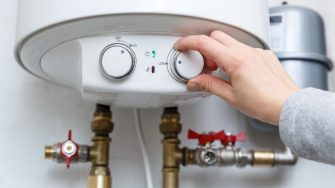UNSW’s new SolarShift project, led by the School of Photovoltaic and Renewable Energy Engineering (SPREE) will coordinate and operate about 3,000 domestic electric water heaters as a giant, ‘Megawatt scale’ thermal battery to soak up excess solar generation and support electricity networks.
The project will be led by UNSW in collaboration with RACE for 2030 industry partners Endeavour Energy (EE), Solar Analytics (SolA), The Office of Energy and Climate Change (OECC) in NSW and Ausgrid, in conjunction with non-RACE for 2030 partners Energy Smart Water (ESW). The project is also part of the International Energy Agency (IEA) Solar Heating & Cooling Program.
The project legacy
The SolarShift project team will create new control strategies and design innovative tariffs for electric water heaters to improve the balance of supply & demand in electricity networks and alleviate challenges attributed to the integration of high levels of rooftop solar power systems.
Since household batteries are not yet economically viable, and more than half (~52%) of Australian homes already have electric water heaters, using the energy storage in these water heater storage tanks can play a major role in the adoption of higher levels of rooftop solar.
“We’re really excited about the potential outcomes of this project,” said project lead Dr Baran Yildiz from UNSW’s School of Photovoltaics & Renewable Energy Engineering. “The majority of households already own an electric water-heating system and coordinating them as a giant thermal battery to soak up the excess solar generation can bring significant financial and environmental savings for the society.”
The two-year project has a total funding of $552,000 and is expected to bring $5.4 million and 64.7 mega-tonnes of CO2 emissions savings towards 2035.
The developed control technology will be utilised via smart meters and will be technology and brand agnostic with the aim to make the project outputs transferrable to the existing and new electric water heating systems.
The impact of this project will also be magnified and enable market transformation internationally through the International Energy Agency (IEA) Solar Heating & Cooling Program.
Australia is the perfect place to develop this technology and will reap the benefits
Australia is the global leader in per capita rooftop solar system installation with approximately 40% of stand-alone homes in QLD and SA and 25% in NSW own rooftop solar systems. Despite clear advantages, integration of high levels of D-PV has also brought challenges.
In low voltage (LV) networks, this manifests as the over-voltage problems experienced in high-penetration regions, especially in rural parts of the network and towards the lower end of the feeders. The experienced high voltages can create power quality issues and cause curtailment of solar and battery systems, limiting the value that can be gained from these distributed energy resources.
Most of the electric water heating systems have 3.6-4.8 kW rated power, which makes up a significant part of the demand in the networks. Their storage tanks offer large thermal storage capacity and can store excess PV generation in thermal energy form. This solution has the added advantages of reducing power bills for consumers by using low-cost solar energy rather than importing grid energy, and of mitigating the minimum operational demand, which threatens the energy-system reliability.
The project partners will bring their unique and complementary strengths to the project.
Solar Analytics and UNSW will build the Solar Shift Consumer Tool which will give households visibility over their water heating system’s energy usage, solar soaking potential and associated savings as well as providing a comparison of different tariff options.
Endeavour Energy will implement different control algorithms developed by UNSW and assess the network benefits that can be gained through coordination of large number of electric water heating systems to soak-up excess solar generation during the middle of the day.
The field trial will test the capabilities of the designed control algorithms and assess consumer value proposition under different network and retail tariff designs.
Dr Yildiz added: “One of the key objectives of the project is to understand how to unlock the value of rooftop solar through schemes like SolarShift and how to fairly allocate the potential benefits across different stakeholders such as networks, retailers, and consumers. We are hoping the findings of this project will pave way for similar applications across other states of Australia and the globe.”
The project is uniquely positioned to make significant impact through cutting edge research and real-world field trials. Results of the project will begin to be shared from July 2023 through RACE for 2030 reports.
UNSW is a partner of RACE for 2030 Cooperative Research Centre (CRC), an industry-led CRC, established in 2020 with $68.5 million of Commonwealth funding. It will invest $350 million of resources over 10 years to deliver lower energy costs and a substantial reduction in carbon emissions.
UNSW, in partnership with RACE for 2030, is undertaking research until 2030 across their Homes, Business, and Networks programs covering technical and non-technical issues, including issues facing everyone such as workforce and trust.
For more information about RACE for 2030 visit their website or contact Marguerite Collins with any enquiries.

